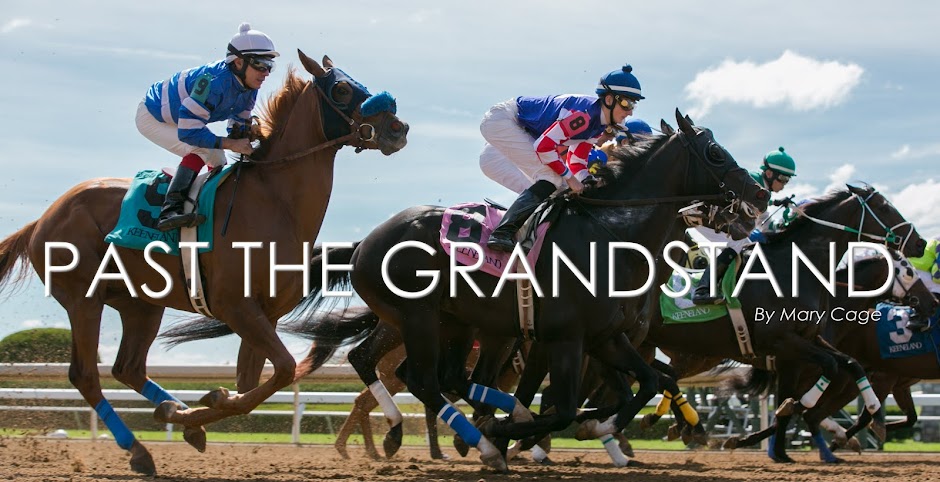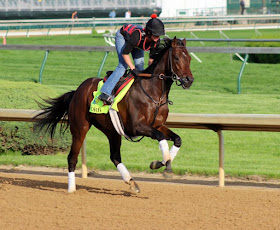Racing fans’ hearts and minds
remain thrilled with memories of the great Frankel, the horse who took the
world by storm, sweeping to prestigious victories across England as he created
a flawless career of fourteen victories in the same amount of starts. Regarded
as one of the greatest racehorse of all-time (and the greatest by many racing enthusiasts and experts), his
retirement was a sad note in racing, particularly European racing. But fans
didn’t have to wait long for another brilliant, undefeated colt to emerge.
Like the sun illuminating the land at daybreak, Dawn Approach arrived on the scene. A powerfully built chestnut with a unique blaze, Dawn Approach marched onto the historic course of the Curragh – the place of the running horse – for the commencement of his career. On a yielding turf course going five furlongs, Dawn Approach tracked the pacesetter, appearing comfortable in second prior to taking the lead within the final quarter of a mile, easily drawing off to win by 1 ¾ lengths. With his victory, Dawn Approach became the first winner for champion New Approach.
Nearly two months elapsed before Dawn Approach went to post again. The scene of his second career start was a good to yielding turf course at Naas Racecourse in Ireland, in which the stunning chestnut would advance to the distance of six furlongs. The race became a breeze for Dawn Approach. After tracking the pace yet again, the Jim Bolger homebred and trainee kicked clear to an effortless 5 ½-length victory.
Advancing to the listed race level, Dawn Approach competed against just five rivals in the Alfred Nobel Rochestown Stakes at Naas. Once more tracking the leader, the Irish-bred colt was ridden vigorously in the final stages of the race, edging clear to score by a comfortable margin that neared 3 lengths.
Fifteen days later emerged the toughest test of Dawn Approach’s career to that point. On opening day of the renowned Royal Ascot meeting, the colt – bred, owned, and trained by Jim Bolger – faced twenty-one opponents in the Coventry Stakes (GII). Was he as talented as he had appeared in his previous starts?
Racing mid-pack in the beginnings of the six-furlong event, Dawn Approach was kept to a position behind the leaders by rider Kevin Manning – the only jockey to ever pilot the colt. Encouraged in the late phase of the race, Dawn Approach became determined to surpass those ahead of him. Relying on sheer talent and ability, the eye-catching chestnut held clear, annexing the race by ¾ of a length over Olympic Glory, who would go on to be a group one winner. Dawn Approach had extended his flawless record to four-for-four and as a result of the prospect of future triumphs and thrills he presented, Godolphin Racing purchased a majority interest in the talent colt, allowing him to remain under the care of Jim Bolger.
Given nearly three months away from the races, Dawn Approach carried the distinguished blue silks of Goldolphin into battle for the first time in the Vincent O’Brien Stakes (GI) (or the National Stakes) – also his first group one challenge. Returning to the Curragh for the event, Dawn Approach settled into third among the small, seven-horse field. As Flying the Flag led the juveniles by a wide margin, Dawn Approach tracked stablemate Leitir Mor.
The tactic of such intense early speed over yielding ground served as Flying the Flag’s hamartia and as said horse struggled home in the final stages of the seven-furlong contest, Dawn Approach unleashed his rally, displaying scintillating acceleration as he drew away to score by 4 ¾ lengths.
Dawn Approach had established himself as one of the best two-year-olds in the land and he was given the chance to confirm this title with a victory in the final start of his juvenile campaign, the Dewhurst Stakes (GI) at Newmarket. Following brief contact with rivals at the beginning of the race, Dawn Approach rated on the outside in third. Over good to soft going, the blaze-faced chestnut gradually improved his position and as each of the six horses in the field commenced their runs, Dawn Approach initially appeared flat. But once he hit his best stride, there would be no denying him. He quickened in a breathtaking manner, his powerful action carrying him to a 2 ¾-length victory.
His flawless record as a juvenile earned him the Cartier Two-Year-Old Colt Award and the title of the winter favorite for the 2,000 Guineas (GI), the first leg of the English Triple Crown. This European classic commenced the colt’s sophomore season and served as redemption for his sire, who finished second in the 2008 installment of the race, beaten a nose by Henrythenavigator.
Sent off as the 11-8 favorite in a field of thirteen, Dawn Approach galloped away from the gate with his usual slight stutter-step and was guided by Manning into mid-pack. Settling behind the leaders, the Jim Bolger trainee galloped contentedly down the straight path of the Rowley Mile Course at Newmarket.
Continuing to gallop along in fourth, Dawn Approach increased his pace with a quarter-mile remaining in the mile-long contest. Gradually, he gained ground on the rivals ahead of him, drawing even with the leaders prior to hesitating to draw clear. However, once he quickened within the final furlong, Dawn Approach exhibited his trademark spectacular turn of foot, extending his advantage on the others with stunning ease as he neared the wire with authoritative strides, capturing the race by an impressive 5 lengths.
Dawn Approach has commemorated his sire in perfect fashion, bearing many similarities to him. Not only is he his first winner, but Dawn Approach is also trained by the same man who conditioned New Approach, Jim Bolger. Like his son, New Approach was honored as the Cartier European Champion Two-Year-Old Colt in 2007, also winning the National and Dewhurst Stakes. Also sent off at 11-8 odds in the 2,000 Guineas, New Approach, however, missed victory by a nose.
This loss was the first blemish on New Approach’s record, but the Jim Bolger trainee continued to shine, winning several high-caliber races, such as the Epsom Derby (GI), the Irish Champion Stakes (GI), and the Champion Stakes (GI). Aside from Dawn Approach, New Approach has sired the likes of the group stakes winners Libertarian, Montsegur, and Newfangled, as well as the stakes winners Talent and Tha’Ir, and the group stakes-placed Bunairgead from his first crop.
New Approach is a son of perhaps the most coveted Thoroughbred stallion in the world, Galileo, who has sired over twenty group one winners, such as Cape Blanco, Frankel, Galikova, Misty for Me, Nathaniel, New Approach, Red Rocks, Rip Van Winkle, Sixties Icon, Together, and Treasure Beach. The multiple group one-winning Galileo was nearly guaranteed to be a spectacular sire, being the result of a mating between two top producers.
The sire of Galileo is none other than the great Sadler's Wells, one of the greatest sires the world has ever seen. The multiple group one-winning son of Northern Dancer was the leading sire by earnings in the United Kingdom for ten years straight and for twelve years total. Sadler's Wells has proven to be an incredible sire of sires, producing not only Galileo, but the outstanding Montjeu, as well as Barathea, El Prado, High Chaparral, In the Wings, and King’s Theatre.
Galileo’s dam is the absolutely tremendous mare Urban Sea, which makes him a half-brother to the great champion Sea the Stars, as well as the grade one-winning My Typhoon, the group stakes-winning Urban Ocean, the stakes-winning and group one-placed horses Born to Sea and Melikah, and the group stakes-placed Cherry Hinton. He is also a full brother to the multiple group one-winning Black Sam Bellamy and the group stakes-winning All Too Beautiful.
Dawn Approach’s dam, Hymn of the Dawn, never amounted to much as a racehorse, losing each of her five starts. Bred in Kentucky, the mare was purchased as a weanling at the 1999 Keeneland November Breeding Stock Sale and was then sent to Ireland. After her unsuccessful racing career, the bay mare began to show little effectiveness as a producer, with her only true success as a broodmare emerging in the form of Dawn Approach.
However, Hymn of the Dawn stems from a superb family. A daughter of the multiple graded stakes-winning sprinter Phone Trick, Hymn of the Dawn shares the same sire as the champions Favorite Trick and Phone Chatter, thus providing Dawn Approach with the same broodmare sire as the grade/group one winners El Inspirado, Exogenous, and Zensational, as well as a multitude of other stakes winners, such as the multiple graded stakes-winning Eye of the Tiger.
Hymn of the Dawn’s dam, Colonial Debut, a daughter of the Kentucky Derby (GI)- and Preakness Stakes (GI)-winning champion Pleasant Colony, also produced the grade one-placed Galantas. The colt’s fourth dam is Kittiwake, a graded stakes winner that foaled a pair of grade one winners. An impeccably bred individual, Kittiwake is a result of the mating between the all-time great Sea-Bird II and the multiple stakes-winning, track record-setting mare Ole Liz, a Reine De Course mare that also produced the multiple graded stakes-winning Oilfield.
Both of Dawn Approach’s parents descend from the Nearctic sire line, with their great-grandsires both being sons of the Canadian Hall of Famer and influential Native Dancer mares. This method of Neartic line-breeding has proved to be tremendously effective, producing the likes of the group one winners Black Caviar, Danedream, Frankel, and Rock of Gibraltar. The blending of pedigrees similar to New Approach and Hymn of the Dawn has proven to be an effectual combination, producing a large percentage of winners, including the stakes-winning Isabell’s Shoes.
And so now this beautifully bred, athletic colt has reached another significant
test in his career: the Epsom Derby (GI). The second leg of England’s Triple
Crown – a prestigious series that has not been swept until 1970 – is his for
the taking. Can he continue to follow in the footsteps of his sire and continue
to display the pure brilliance he has exhibited?



















